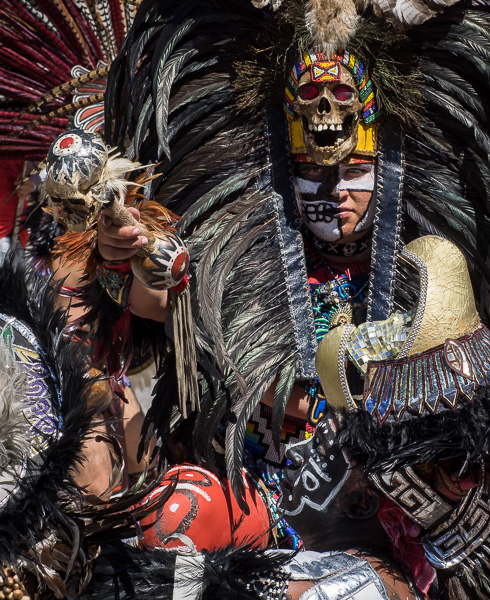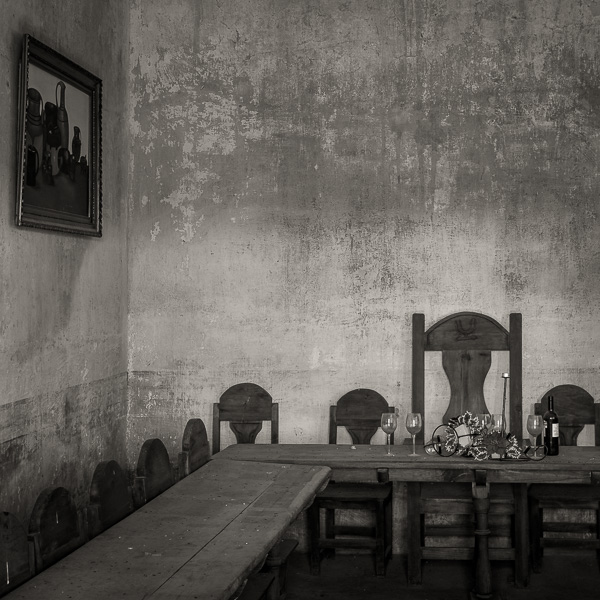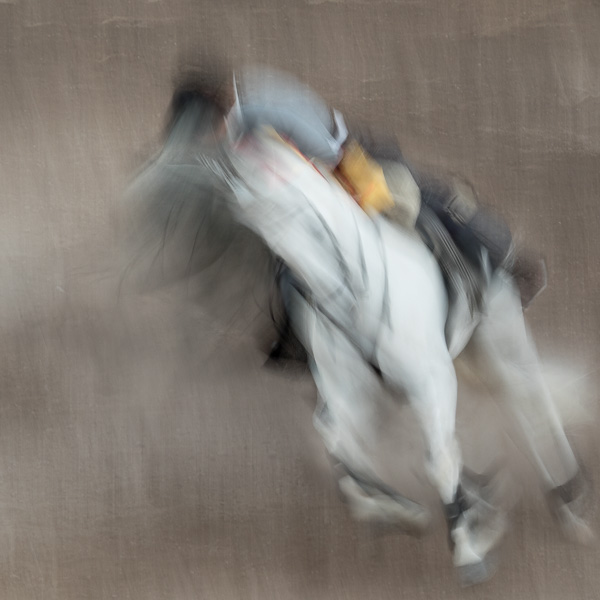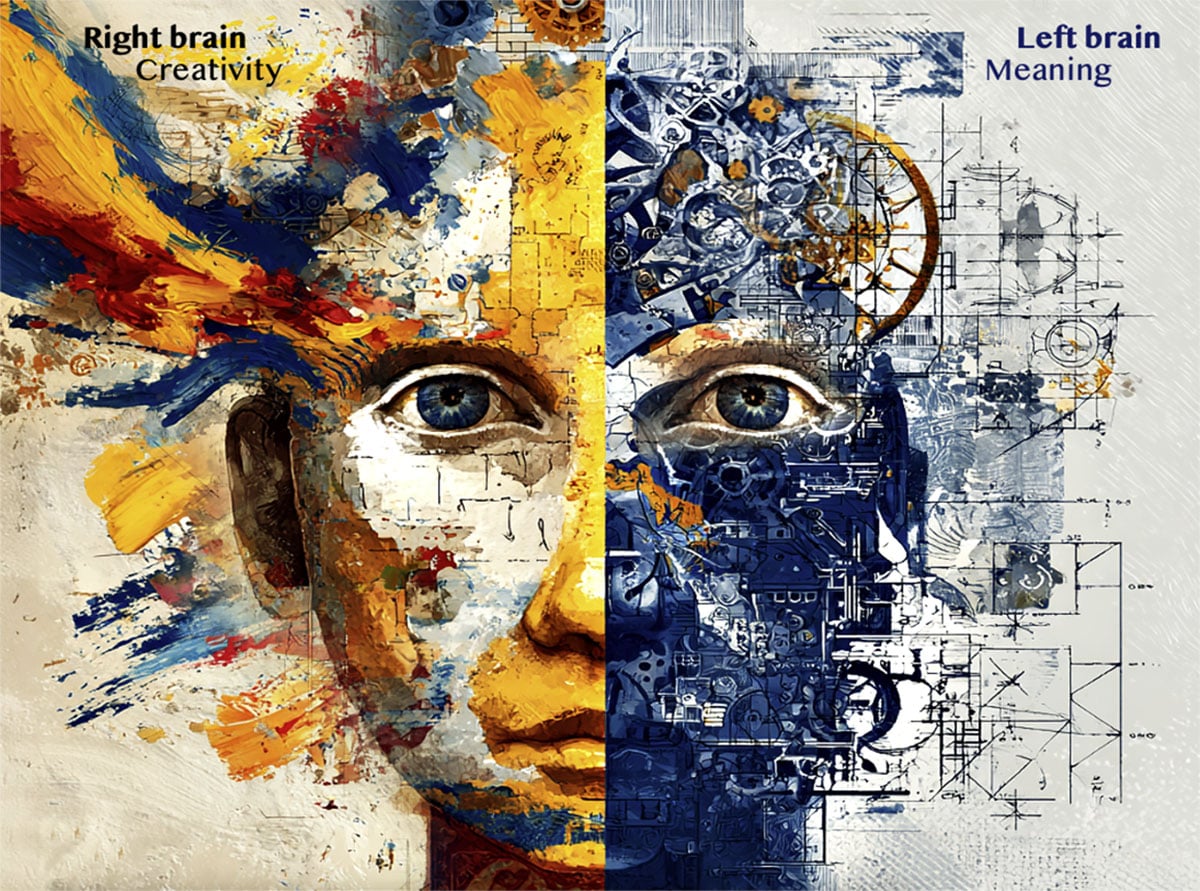This review was initially of a pre-production camera loaned to me by Olympus for testing.
At their request I agreed not to test image quality or publish photographs until they could provide
a production version of the camera. They have now done this and my analysis of the C-8080’s image quality
is foundbelow. Please note that I have not altered the first part of this review in any way. My conclusions regarding the
camera’s build quality, features, specs and handling remain unchanged, and any additional comments are part of the new section.
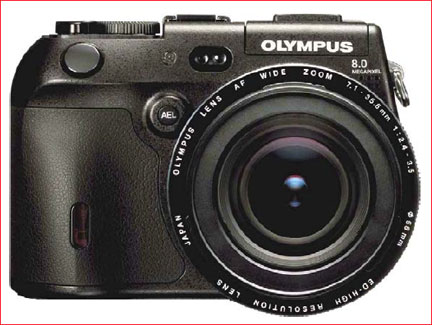
Sony Corporationis one of the world’s largest manufacturers of CCD imaging chips, used in digital cameras offered by many different companies. In the summer of 2003 Sony announced that it had developed an 8 Megapixel 2/3" CCD imaging chip. Sony themselves launched theirF-828camera utilizing this chip toward the end of that year, and now, in February 2004, four other companies have announced and are preparing to ship 8 Megapixel cameras.
I think of these as "crossover"cameras. They are more than digital point-and-shoots (ordigicamsas they are sometimes called), but because of the lack of an optical SLR design, using instead an electronic viewfinder (EVF), and also the lack of interchangeable lenses, they aren’t in the same league as Digital SLRs (DSLR). Nevertheless these are highly versatile cameras, and can meet the needs of a great many photographers including pros, under conditions where a small light-weight camera capable of producing large high-quality images is needed. Oh yes, and the price for almost all of these crossovers is about $1,000, often less than just the price of a 35mm format lens of similar capabilities.
Note that this review does not include a recitation of every knob, button, and each menu item’s behavior. I am more concerned with how well these each do their job than with listing them catalog style. I refer you toOlympus‘ web site for this type of information, and also to the very detailed camera reports onDPReview.
By Comparison
When reviewing a product, especially one where there will be five major comparators appearing in the same market niche at almost the same time, it only makes sense to draw comparisons between them. Since at the time of testing the Olympus C-8080 the only other competitive camera available is the Sony F828, it will serve as my reference point. I have now been using that camera for about three months, have shot nearly three thousand frames with it on three continents, and have become very familiar with both its strengths and weaknesses. My Sony review is available on this site in three parts;Sony DCS F828,Digital Bridge Cameras andCognitive Dissonance, andSony F828 – Part II.
Olympus’ Bid
TheC-8080 Wide Zoom, to use its full name, is Olympus’ bid to enter the 8 Megapixel crossover digital camera race. It features an Olympus 7.13 – 35.6mm f/2.4-f/3.5 zoom lens, which is the equivalent in 35mm terms to 28 – 140mm. The range is 5X. With a 28mm equivalent focal length at the wide end this is as wide as the current generation of digicams get, though I wonder at Olympus’ use of "Wide Zoom" in its name, as just about every other camera in its class features this focal length. I’ll have more to say on the lens, below.
The camera is powered by a 1,500 mAh lithium ion battery, similar in design and power to those used in many other cameras. The C-8080 comes with a small charger suitable for travel. Though I didn’t run a full test, battery life appears to be significantly lower than the Sony F828. With that camera I regularly get 200-250 exposures on a battery, depending on the ambient temperature, but with the Olympus I saw about 100 frames before the battery was depleted. This shortfall is likely due in part to the use of an electric rather than a manual zoom.
There is also no continues battery meter. When a red flashing low battery logo appears on-screen there may be 15-20 frames left. But until that point one has no idea if the battery is fresh or half gone. The Sony, for its part, has a very informative and "smart" continuous battery level monitoring system.
An effective lens shade is provided and also a small wireless remote shutter release. But, the lens shade will not fit on the lens reversed for transport.
The camera’s design is an evolution of previousCamediamodels, in combination with some control and interface elements from previous Olympus E series cameras. There is a solid AF system, though somewhat slow at low light levels, a built-in pop-up flash, and a wide range of additional features and capabilities, some of which will be explored below.

Economy Handle — Toronto, February, 2004
Olympus C-8080 @ ISO 50
Design and Ergonomics
The C-8080 has a very smoothly rounded and elegant design, similar in many ways to its big brother theE-1. Material quality is first rate, and the texture and shape of the grip are almost perfect. The shutter release is properly located and has a firm but progressive action. The camera is small (possible, as will be seen,toosmall), but hefty.
The zoom lever is located right behind the shutter release, but regrettably is not of a progressive design. In other words — it only has one speed — slow. From 28mm to 140mm takes about 3 seconds. A manual zoom can cover the same range in less than half a second. Also, there is no indication on the lens of the focal length selected. There’s an indication in the viewfinder of where in theTtoWspectrum you are, but nothing to indicate the focal length, either in actual or 35mm terms.
There is no power light on the camera. Unless the rear LCD is being used, there is no way to tell at a glance if the camera is turned on or not. Yes, the lens does protrude slightly more when the camera is turned on than when it’s off, but that is not a quick-to-notice signal. With the camera set to 3 minute shut-down to save battery, I found myself frequently turning the camera off when I meant to turn it on to take a shot, and visa versa. The Sony has a clear and bright green LED on the top panel near the shutter release, right where you’ll look when you take the camera to hand to take a photograph. My suggestion to Olympus is to turn the red raised index marker on the top panel into an LED on future models.
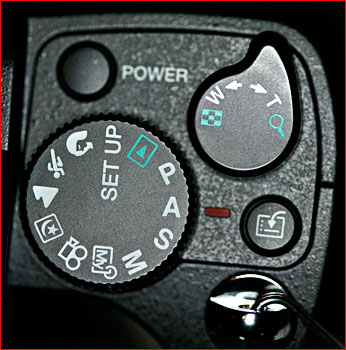
The shooting Mode dial on the C-8080 is almost flush with the top right-hand surface of the camera. Too much so. Because of its low profile it is somewhat difficult to turn with bare fingers, and almost impossible with gloves on. This design flaw is compounded by the fact that the Power button is located right next to it, and almost flush with the top surface of the camera. I found that nearly 100% of the time, when I went to turn the Mode dial I would accidentally press the Power button. Ones index finger is almost forced into that position to avoid the raised zoom lever that is right next to it. (My fingers are actually on the small side, so that’s not the source of the problem).
The Sony Mode dial, by comparison, sits high and proud of the top panel of the F828, and is easy to turn even if wearing ski gloves. The Sony’s power switch is also a spring loaded sliding lever which is almost impossible to actuate accidentally, but which can easily be turned on or off with gloves on.
There is the usualSet-Upposition on Olympus’ shooting mode dial. I usually object to this design approach because it prevents the camera from having picture taking priority. In other words, if you’re in the midst of changing some parameter and you want to take a photograph, you have to remember to move the dial back to a shooting mode. You’ll likely miss the shot of the alien mothership landing on top of the Polar Bear.
Having said that, the Olympus is better than most cameras in this regard because there are only a small number of settings which need to be made in this position. Rather, one can access most of the cameras settings while in shooting mode by pressing the OK button on the rear panel. Olympus has done a good job of solving this design problem that many other manufacturers, including Sony, seem to have ignored.
Because of the camera’s narrow width there is no top-panel data LCD. There simply isn’t room for one. Most cameras have one to show you information that you need to know, without having the camera up to ones eye, or held away from the body so that the rear LCD screen can been clearly seen. This information usually includes battery condition, flash mode, shutter speed, F stop, and sometimes ISO setting. The number of frames remaining is also a piece of information that one wants to have visible at all times, whether the cameras is hanging from ones neck or sitting on a tripod. I regard the lack of such a data-LCD is a serious deficiency with the C-8080.
The Lens
The lens on the C-8080 is not as fast as that on the F828 (f/2.4 vs. f/2.0) not does it reach as far on the long end (140mm vs. 200mm). When the C-8080 is turned off, the lens is partially withdrawn in the body, and thus the total length of the body / lens combination is 110mm. With the lens extended to maximum telephoto position it is 145mm. The lens on the Sony does not changed size when zoomed, and is always 165mm from filter ring to eyecup. Not that big a difference given the considerable difference in focal length. But the Olympus is considerably shorter when turned off.
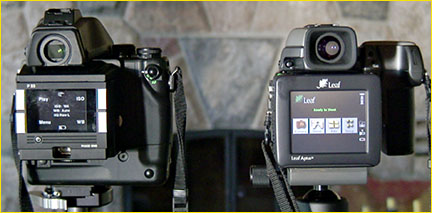
Olympus C-8080 / Sony F828
I have a serious concern about the use of an electronic zoom on the C-8080. This makes the camera slow to use and also noisy. I much prefer the manual zoom of the Sony F828. This criticism is not limited to the Olympus, as several other cameras in this category are similarly designed. I find electronic zooms to be totally out of character on a camera with serious pretensions, such as this new group of 8 Megapixel models.
I also found the autofocus to be noisy. In a typical office or home environment it was annoying to hear the lens whirring as it tried to lock focus. The Sony F828 by comparison is totally silent when autofocusing.
The LCD and EFV
The rear LCD has good low light lag characteristics, better than the F828, but is not as bright, and also it appears to have a dull bluish cast. The EVF has a similar blue cast, and appears duller than the EVF on the Sony. This characteristic is described more fully a bit further on in this section.
The Olympus’ EVF has a lower eyepoint than that on the Sony. By this I mean that it appears to be somewhat smaller and farther away. On the Sony you are looking at a screen. On the Olympus you’re looking at a screen at the end of a short tunnel.
Another related area where the C-8080 causes me some concern is with the button that switches between the rear LCD and the EVF. It is a simple press and can be actuated accidentally, especially when one is wearing gloves. As discussed below the same thing applies to the button which switches between cards. The Sony has firm sliding switches for both of these functions, which are almost impossible to move by accident, a design that I find at times annoying because they are almosttoostiff, but at least they stay where they are set.
Of possibly the greatest concern is the behavior of the viewfinder (either one) when used in low light levels. The Olympus’ screens are dull and dim, and only achieve "normal" brightness momentarily (equivalent brightness to that of the Sony, for example) once the shutter has been partially depressed and focus is locked. This is a real hindrance to low light level composition and I don’t understand why this needs to be the case.
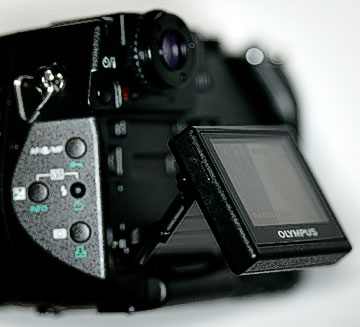
The rear LCD screen is mounted on an extendable articulated panel. This allows it to be angled at about 30 degrees, as seen above, or at 90 degrees horizontally. It can also be positioned at about 45 degrees downward, which is usefull for shooting overhead. I noted that extending the LCD turns the camera on — a thoughtful bit of design. But, I am concerned with the long-term durability of this design. An accidental knock looks like it could well do some damage, while the Sony’s hefty articulated body has the feel of a bank vault door by comparison.
Furthermore, and I think this is a reflection of that fact that the camera may indeed be a bit too small for the number of finger controls provided, when I grip the screen by the side tabs intended my left thumb invariably activates the Quick Review button. If instead I grasp the screen lower down I always accidentally press the button which changes from LCD to EVF viewing, an even greater annoyance. Too many non-interlocked buttons in too small a space.
Image playback takes about 4 seconds per image. The Sony on the other hand is essentially instantaneous, no matter how many frames are reviewed in succession. This indicates that the Sony is buffering a display of the last image shot, and also buffers ahead the next frames when you’re reviewing more than one. Olympus really needs to look at what the competition is doing in some of these areas.
It’s in the Cards
The C-8080 takes bothCompactFlashandxD-Picturecards. I am not a fan of this new small card format. They are simplytoosmall. Small enough to get lost underneath a postage stamp. Literally. For a user who never changes cards, and who transfers files with the supplied USB cable, then this will make little difference. But for anyone shooting a lot, who changes cards in the field, having a card that if dropped in the grass could literally be carried off by a couple of energetic ants — well, to my mind these are not a good idea. Thank goodness Olympus included CompactFlash capability as well. My advice is to forget Xd cards. Simply get yourself a couple of decent capacity CompactFlash cards or a Microdrive.
The camera features a rear-mounted button which allows switching between the xD and CF cards. I would much rather have seen a sliding switch, or some other control that wasn’t as easily changed by accident. While the camera notably requires that many settings be changed by the press of two buttons at once, this button can be activated by itself. Ending up with images on the wrong card can be frustrating.
The card door does not have a latch. I must admit that I spent a couple of minutes at first trying to find one. (Yes, Idoread manuals, but my habit is to first try and see how intuitive a camera’s design is without reference to the instructions). To open the door means putting a finger nail into an indent in the rear panel. Once again this makes operating the camera with gloves on problematic. They get winter in Japan. Don’t Olympus’ engineers ever go out shooting when its cold? Does anyone actually test these designs in the real world? It makes me wonder.
The xD card pops in and out with alacrity, but the CF card can be problematic. It’s a snug fit for ones fingers to extract the card. There is a small pivoting lever that is used to eject the CF card, but it takes a decisive push so that the card almost pops out for there to be enough room to grasp the card to remove it. Not as bad as the card slot on thePentax *istD, but not as simple and straightforward as it should be.
Screens and Menus
It seems that the Olympus offers at least two different ways to accomplish most functions. Rather than being confusing, it’s actually very well thought out.

For example, the left side of the camera has six buttons in addition to the manual flash pop-up control. These activate a range of settings, including White Balance, recording mode, autofocus mode, flash mode, exposure compensation and metering modes. All of these are also available from menus. I also greatly appreciate a button that’s located on the top panel, near the mode dial, which when pressed this can be programed to activate any of a series of user-selectable items. I set it to ISO adjustment and found it to be very handy.
Otherwise, there’s little to fault and much to like about the C-8080’s menu system. It’s better than some, and not as good as others, but this is one of the toughest aspects of camera design to do well, and I really can’t fault Olympus too much in this area.
Raw Mode
Like the Sony F828 the Olympus C-8080 is able to shoot in RAW mode. But as with the Sony this mode is almost unusable because the camera takes forever (actually about 20 seconds — a bit slower than the Sony) to write a RAW file to disk. During this time the camera is unusable. Sorry Olympus and Sony — that’s not the way I do photography. Shooting Degeurotypes is faster. Spend a few more dollars and put in a bit more buffer memory and also a microprocessor that’s able to walk and chew gum at the same time. Totally frustrating!

Funnel — Toronto, February, 2004
Olympus C-8080 @ ISO 50
The Kitchen Sink
As with most digital cameras these days there are so many features that it’s tedious to list them all, let alone comment on them. Ones that are found on the C-8080, and which are worth mentioning but not exploring in detail here, include…
— multi-point spot metering
— autofocus illumination assistance
— live histogram with a unique highlight and shadow area display
— a "My" mode position into which you can program virtually every camera setting (handy for a quick switch). I wish every camera maker would emulate this
— long exposure noise reduction
— a Movie mode
— Flash hot shoe accepting dedicated flash units as well as connection to external flash
— autobracketing
— panoramic stitching assist mode
— time exposures up to 8 minutes
— ISO modes from 50 to 400, in fine increments
I could go on, but I’m getting bored, and you likely are as well. Sometimes I long for the days of the M Series Leica, with a shutter speed dial and an aperture ring, and that’s it! Now we have cameras with 200 page manuals and so many features that even regular users can’t remember (or need) most of them. Such is progress. But I digress.
Conclusion and Recommendation
If you’ve read this review from beginning till this point you’ll likely have been unable to escape the conclusion that Olympus needs to do a bit more homework when it comes to designing features and functions. Image quality completely aside, the C-8080 simply isn’t competitive with the Sony F828 in a large number of areas.
Given the functional superiority of the Sony, and the fact that there will be highly competitive cameras coming along soon from Nikon, Canon and Minolta, it’s hard to see how one can recommend the Olympus C-8080.
You may also enjoy reading a related essay titled:
The Case of the
Nit Picking Pixel Peepers
Olympus C-8080 Image Quality Analysis
A Review Update
This review update will concern itself primerily with the C-8080’s image quality. My initial review above ommitted this, at the request of Olympus, because the camera that I had available was a pre-production sample. I have now has the opportunity to test a full production camera.
While that is the topic for this section I would like to comment on the fact that I have also revisited the camera’s features, functions and ergonomics and have found nothing in this production camera that would cause me to change my mind about what I have written earlier. Indeed, I have now started to test some of the other 8MP contenders, and find that the C-8080 suffers by comparison.
Preamble
Here is how my image testing began…
A couple of days after receiving the second Olympus body for testing I had an opportunity to take several of the new 8MP cameras out for a comparison shoot. Because it can slow me down in the field, the night before I set all of the different cameras to matching modes; Aperture Priority, F/5.6, ISO 50 or 64, RAW mode with fine JPG, and so on.
The next day I ran a lengthy series of comparisons in the field. I noticed that the Olympus had not retained the aperture that I had set the night before, but didn’t think much of it after resetting it to f/5.6. But when I returned to the office and started analyzing the various camera’s files I found that the C-8080 had not retainedanyof the settings made the night before. Instead of shooting in RAW mode with accompanying ultra-fine JPG, the camera had performed all of the test shots in HQ (which is basic quality JPG) with no accompanying RAW files. The whole comparison of all the cameras would now have to be re-shot.
I hadn’t noticed this at the time because I had a total of six different cameras in front of me. Normally I might have noticed that the Olympus wasn’t shooting RAW files awfully quickly, but I didn’t because at least half the cameras I was shooting with were able to shoot multiple RAW files in quick succession, rather than suffering the 15 odd second delay that the Olympus and some of the other 8MP cameras display.
Why had this happened? Because the default mode of the camera is to reset all of the camera’s shooting parameters whenever it is turned off. Buried in the Setup menu, on the second level along with the adjustment for the BEEP sound, is found — ALL RESET — with the default being ON. This means that all settings are always reset every time the camera powers down. Of course this is explained somewhere in the manual, but it seems to me to be the opposite of what most users would want as a default mode.
And people wondered why I have been negative about this camera’s user interface design.
Missing in Action
When I was evaluating the pre-production C-8080 I couldn’t find several expected functions. I assumed that they were there somewhere, but since there was no user manual I could not find them. The production camera comes with a 185 page manual, but it’s in four languages, and though I found it to be comprehensive, it’s quite brief. It turns out that the reason that I couldn’t find various worthwhile functions the first time is because they just don’t exist on the C-8080.
These included audio recording capability with still images (it does record sound in video mode, of course). Also there was no overexposure warning, and no real-time histogram. There isn’t even an image review histogram on payback.
Update:I stand corrected. There is a real time histogram, and also audio recording capability. I am told that the histogram information is found on Page 119 of the PDF manual found on the CD (it does not appear in the printed manual), and the audio recording information is to be found on Page 100 of the PDF manual, but also not in the printed manual. What can I say?
Given all of the C-8080’s shortcomings, especially when compared to the similarly priced offerings of its prime competitors, I can only assume that Olympus has misjudged the market. The other manufacturer’s see this generation of 8MP cameras as bridges to a new generation of technology and users. Someone buying one of these cameras is attracted by the technology. They want to be able to make large (A3) sized prints of high quality, and they are serious about their photography. They may not have the money to purchase a DSLR and a couple of fast zoom lenses, or they may value the small size and light weight of a non-SLR design. But, they are also unlikely to be happy making compromises when it comes to features and functionality, especially when there are highly competitive products at comparable prices.
It appears to me that Olympus has produced a previous-generation camera but using a current generation imaging chip. In today’s fast-paced digital camera environment this simply doesn’t cut it.
Colour Accuracy
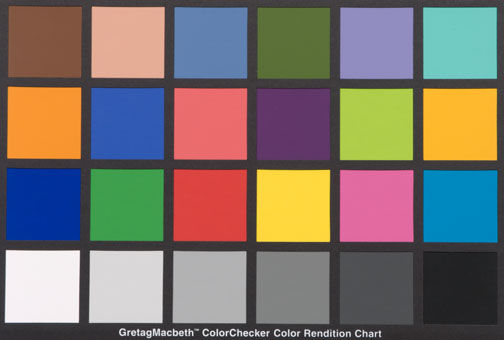
As always with viewing colour charts online, please go by what I say, not by what you see.
Even if you have a profiled and calibrated screen, because this file has been converted to sRGB
from Adobe RBG there will be differences between what I see on my Sony Artisan monitor and what you may see.
It’s always informative to shoot a Macbeth ColorChecker chart and see how well a particular camera handles the issue of colour accuracy. The methodology is simple. Photograph the chart under controlled lighting conditions and then load it into the RAW converter. Click on the 18% gray square with the gray point selector (to set the colour balance) and see what happens to all of the colours.
Skin tones are slightly pinker than the second from top left square, while greens seem desaturated. Bluish-green (upper right) is rendered very accurately. All the other colours reproduce very accurately, except for orange-yellow (second down on the right) which is slightly too deep in tone. Red is a little low in intensity but magenta and purple are accurate.
The C-8080 is one of the most accurate digicams that I’ve yet tested when it comes to colour fidelity.
DxO Analyzer Evaluation
The Olympus C-8080 perfomed very well on the DxO Analyzer.Results are found here. In virtually every measure the Olympus C-8080 measures better than the Sony F828, though the Minolta is the champ when it comes to resolving power. It remains to be seen how it will compare with the comparable Canon and Nikon offerings, but certainly of the three cameras tested thus far the Olympus’ image quality measures very well indeed.
Whether the issues that I have explored in the review aboveconcerning the camera’s features (or their lack), and whether its ergonomic failings will outweight the image quality performance for any individual photographer is something that each person has to decide for themselves.
Read this story and all the best stories on The Luminous Landscape
The author has made this story available to Luminous Landscape members only. Upgrade to get instant access to this story and other benefits available only to members.
Why choose us?
Luminous-Landscape is a membership site. Our website contains over 5300 articles on almost every topic, camera, lens and printer you can imagine. Our membership model is simple, just $2 a month ($24.00 USD a year). This $24 gains you access to a wealth of information including all our past and future video tutorials on such topics as Lightroom, Capture One, Printing, file management and dozens of interviews and travel videos.
- New Articles every few days
- All original content found nowhere else on the web
- No Pop Up Google Sense ads – Our advertisers are photo related
- Download/stream video to any device
- NEW videos monthly
- Top well-known photographer contributors
- Posts from industry leaders
- Speciality Photography Workshops
- Mobile device scalable
- Exclusive video interviews
- Special vendor offers for members
- Hands On Product reviews
- FREE – User Forum. One of the most read user forums on the internet
- Access to our community Buy and Sell pages; for members only.








